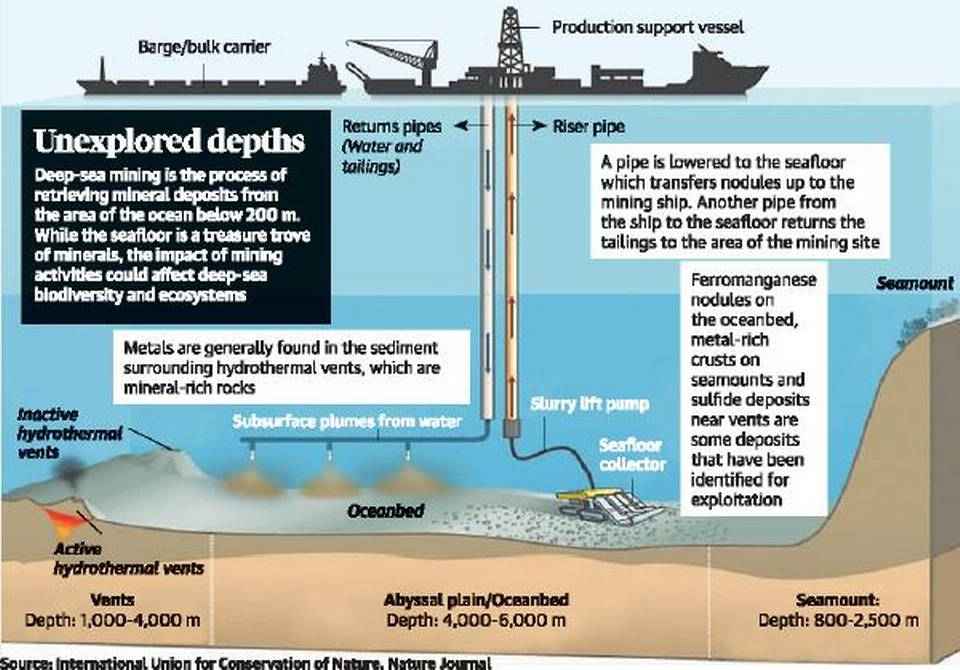Science & Technology
Deep Ocean Mission
- 17 Mar 2022
- 7 min read
For Prelims: Deep Ocean Mission (DOM), Blue Economy, Manned Submersible Vehicle, National Institute of Ocean Technology (NIOT), International Seabed Authority,
For Mains: Deep Ocean Mission (DOM), Government Policies & Interventions, Scientific Innovations & Discoveries, Blue Economy
Why in News?
Recently, the Ministry of Earth Sciences has launched the Deep Ocean Mission (DOM).
- DOM is a mission mode project to support the Blue Economy Initiatives of the Government of India.
- Earlier, the Ministry of Earth Sciences had also rolled out the draft Blue Economy Policy.
- Blue Economy is the sustainable use of ocean resources for economic growth, improved livelihoods and jobs, and ocean ecosystem health.
What are the Major Components of DOM?
- Development of Manned Submersible Vehicle:
- A manned submersible will be developed to carry three people to a depth of 6,000 metres in the ocean with a suite of scientific sensors and tools.
- NIOT & ISRO is jointly developing a Manned Submersible Vehicle.
- National Institute of Ocean Technology (NIOT), an autonomous institute under the Ministry of Earth Sciences.
- Development of Technologies for Deep Sea Mining:
- An Integrated Mining System will be also developed for mining polymetallic nodules at those depths in the central Indian Ocean.
- Polymetallic nodules are rocks scattered on the seabed containing iron, manganese, nickel and cobalt.
- The exploration studies of minerals will pave the way for commercial exploitation in the near future, as and when commercial exploitation code is evolved by the International Seabed Authority, a United Nations (UN) organisation.
- An Integrated Mining System will be also developed for mining polymetallic nodules at those depths in the central Indian Ocean.
- Development of Ocean Climate Change Advisory Services:
- It entails developing a suite of observations and models to understand and provide future projections of important climate variables on seasonal to decadal time scales.
- Technological Innovations for Exploration and Conservation of Deep-sea Biodiversity:
- Bio-prospecting of deep-sea flora and fauna including microbes and studies on sustainable utilisation of deep-sea bio-resources will be the main focus.
- Deep Ocean Survey and Exploration:
- It will explore and identify potential sites of multi-metal Hydrothermal Sulphides mineralization along the Indian Ocean mid-oceanic ridges.
- Energy and Freshwater from the Ocean:
- Studies and detailed engineering design for offshore Ocean Thermal Energy Conversion (OTEC) powered desalination plants are envisaged in this proof of concept proposal.
- OTEC is a technology that uses ocean temperature differences from the surface to depths lower than 1,000 metres, to extract energy.
- Advanced Marine Station for Ocean Biology:
- It is aimed at the development of human capacity and enterprise in ocean biology and engineering.
- It will translate research into industrial application and product development through on-site business incubator facilities.
What is the Significance of DOM?
- Leveraging Ocean Resources: Oceans, which cover 70% of the globe, remain a key part of our life. About 95% of the Deep Ocean remains unexplored.
- Three sides of India are surrounded by the oceans and around 30% of the country's population lives in coastal areas, the ocean is a major economic factor supporting fisheries and aquaculture, tourism, livelihoods and blue trade.
- Considering the importance of the oceans on sustainability, the UN has declared the decade, 2021-2030 as the Decade of Ocean Science for Sustainable Development.
- Long Coastline: India has a unique maritime position. Its 7517 km long coastline is home to nine coastal states and 1382 islands.
- The Government of India's Vision of New India by 2030 announced in February 2019 highlighted the Blue Economy as one of the ten core dimensions of growth.
- Technology Expertise: The technology and expertise needed in such missions are now available in only five countries - the US, Russia, France, Japan and China.
- India will now be the sixth country to have it.
What are other Blue Economy Initiatives
- India-Norway Task Force on Blue Economy for Sustainable Development:
- It was inaugurated jointly by both the countries in 2020 to develop and follow up joint initiatives between the two countries.
- Sagarmala Project:
- The Sagarmala project is the strategic initiative for port-led development through the extensive use of IT-enabled services for the modernization of ports.
- O-SMART:
- India has an umbrella scheme by the name of O-SMART which aims at regulated use of oceans, marine resources for sustainable development.
- Integrated Coastal Zone Management:
- It focuses on the conservation of coastal and marine resources, improving livelihood opportunities for coastal communities etc.
- National Fisheries Policy:
- India has a National Fisheries policy for promoting the 'Blue Growth Initiative' which focuses on sustainable utilisation of fisheries wealth from marine and other aquatic resources.
PYQ
If National Water Mission is properly and completely implemented, how will it impact the country? (2012)
1. Part of the water needs of urban areas will be met through recycling of waste-water.
2. The water requirements of coastal cities with inadequate alternative sources of water will be met by adopting appropriate technologies that allow for the use of ocean water.
3. All the rivers of Himalayan origin will be linked to the rivers of peninsular India.
4. The expenses incurred by farmers for digging bore-wells and for installing motors and pumpsets to draw ground-water will be completely reimbursed by the Government.
Select the correct answer using the codes given below:
(a) 1 only
(b) 1 and 2 only
(c) 3 and 4 only
(d) 1, 2, 3 and 4
Ans: (b)







